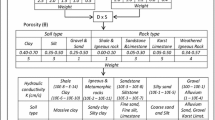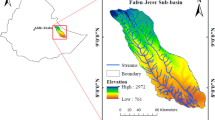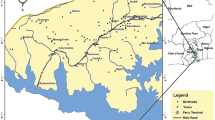Abstract
Five different methods for assessing intrinsic aquifer vulnerability were tested in a case study and their results compared. The test area was a slightly karstified district in the Condroz region of Belgium. The basin covers about 65 km2 and the karst aquifer provides a water-supply of about 28,000 m3d-1. The methods tested were: EPIK (Doerfliger et al. 1999), DRASTIC (Aller et al. 1987), 'German method' (von Hoyer and Söfner 1998), GOD (Foster 1987) and ISIS (Civita and De Regibus 1995). The results are compared and critically examined. From the analysis, it seems that reducing the number of parameters is unsatisfactory, due to the variety of geological conditions. The various methods produce very different results at any given site. As only physically-based methods can be checked for their reliability, it is clear that future vulnerability mapping techniques must incorporate such methods.










Similar content being viewed by others
References
Aller L, Bennet T, Lehr HJ, Petty JR, Hackett G (1987) DRASTIC: a standardized system for evaluating ground water pollution potential using hydrogeologic settings. In: Ada OK, Robert S. Kerr Environmental Research Laboratory, US Environmental Protection Agency Report EPA-600/2–87–035, 622 pp
Brouyère S, Jeannin P-Y, Daly D, Dassargues A, Dunne S., Goldscheider N, Malik P, Popescu IC, Sauter M, Vadillo I, Zwahlen F (2001). Evaluation and validation of vulnerability concepts using a physically based approach. In: Mudry J, Zwahlen F (eds). 7th Conference on limestone hydrology and fissured media, Besancon, France, pp 67–72.
Civita M (1994) Le carte della vulnerabilità degli acquiferi all'inquinamento. Teoria & practica (Aquifer vulnerability maps to pollution) (in Italian). Pitagora Ed, Bologna
Civita M, De Regibus C (1995) Sperimentazione di alcune metodologie per la valutazione della vulnerabilità degli aquiferi (in Italian). Quaderni di Geologia Applicata, Pitagora Ed. Bologna, 3, pp 63–71
Corniello A, Ducci D, Napolitano P (1997) Comparison between parametric methods to evaluate aquifer pollution vulnerability using GIS: an example in the "Piana Campana", southern Italy. In: Marinos PG, Koukis GC, Tsiambaos GC, Stournaras GC (eds). Engineering Geology and the Environment, Balkema Rotterdam: 1721–1726
Daly D, Dassargues A, Drew D, Dunne S, Goldscheider N, Neale S, PopescuI C, Zwahlen F (2001) Main concepts of the 'European Approach for (karst) groundwater vulnerability assessment and mapping. Hydrogeol J 10:340–345
Dassargues A, Derouane J (1997) A modelling approach as an intermediate step for the study of protection zones in karstified limestones. Karst Hydrology, Proc workshop W2, Rabat, Morocco, IAHS Publ. No 247, pp 71–79
De Boyer C, Thys G, Fairon J, Michel J, Vrolix M (1996) Atlas du karst Wallon—Inventaire catographique et descriptif des sites karstiques et des rivières soutteraines de la Walonie- Province de Liège, La commission Wallonne d'étude et protection des sites souterrains, Belgium
DeMers M N (1997) Fundamentals of geographic information systems. Wiley, New York
Doerfliger N., Jeannin P-Y, Zwahlen F (1999) Water vulnerability assessment in karst environments: a new method of defining protection areas using a multi-attribute approach and GIS tools (EPIK method). Environ Geol 39(2):165–176
ESRI (1997) The Arc/Info version 7.1 software package documentation, Environmental Systems Research Institute Inc, USA
Foster SSD (1987) Fundamental concepts in aquifer vulnerability, pollution risk and protection strategy. In: van Duijvenbooden W, van Waegeningh HG (eds) TNO Committee on Hydrological Research, The Hague. Vulnerability of soil and groundwater to pollutants, Proc Inf 38, pp 69–86
Gogu RC, Dassargues A (2000a) Current trends and future challenges in groundwater vulnerability assessment using overlay and index methods. Environ Geol 39(6):549–559
Gogu RC, Dassargues A (2000b) Sensitivity analysis for the EPIK vulnerability assessment in a small karstic aquifer. Hydrogeol J 8:337–345
Meus P (1993) Hydrogéologie d'un aquifère karstique du calcaire carbonifère en Belgique (Néblon et Anthisnes). Apport des traçages à la connaissance des milieux fissurés et karstifiés (in French). PhD Thesis, University of Liège, Belgium, 323 pp
Tripet J-P, Doerfliger N, Zwahlen F (1997) Vulnerability mapping in karst areas and its uses in Switzerland. Hydrogéologie 3:51–57
von Hoyer M and Söfner B (1998) Groundwater vulnerability mapping in carbonate (karst) areas of Germany, Federal institute for geosciences and natural resources, Archiv no 117854, Hanover, Germany, 38 pp
Vrba J, Zaporozec A (1994) Guidebook on mapping groundwater vulnerability. Int Contrib Hydrol 16:131 pp
Acknowledgements
Particular thanks are given to Bob Aldwell and to Coran Kelly, Geological Survey of Ireland, for their helpful technical reviews.
Author information
Authors and Affiliations
Corresponding author
Rights and permissions
About this article
Cite this article
Gogu, R.C., Hallet, V. & Dassargues, A. Comparison of aquifer vulnerability assessment techniques. Application to the Néblon river basin (Belgium). Env Geol 44, 881–892 (2003). https://doi.org/10.1007/s00254-003-0842-x
Received:
Accepted:
Published:
Issue Date:
DOI: https://doi.org/10.1007/s00254-003-0842-x




